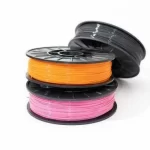This one has multiple fins which have been cut from a solid block of copper, an excellent heat transfer material. This is an example of a passive heat sink since there is no fan attached to it.
How Does a Heat Sink Work?
A heat sink makes use of the principles of conductive, convective, and radiative heat transfer to move heat from a hotter source to a lower-temperature fluid. Heat is conducted from this source into the sink. Heat sinks are produced from materials with a large heat capacity, i.e. they can store more heat per gram of material. This heat then transfers from the sink into the surrounding fluid via convection and radiation. The heat transfer rate is increased by having a large surface area in contact with the heat exchange fluid. Surface area can be dramatically increased by cutting fins into the heat sink base material.
A heat sink may be passive or active. An active heat sink makes use of the forced convection created by a fan or pump to rapidly transfer heat from the device, while a passive heat sink makes use of natural convection.
What Is the Purpose of a Heat Sink?
A heat sink is designed to dissipate waste heat caused by the operation of electrical or mechanical devices. This waste heat can build up and cause failures in a device or reduce its overall performance if it is not moved away from the component.
What Are the Key Components of a Heat Sink?
A heat sink is a relatively simple device. Listed below are the five components that make up a typical heat sink:
1. Base
A heat sink base is typically a flat block or sheet of material with excellent thermal conductivity. The base typically has a consistent cross-sectional thickness, but it can also be designed to have a cross-sectional profile that optimizes heat transfer for the specific geometry of the heat source. The base is typically mounted to the heat source with mounting hardware and thermal paste.
2. Fins
Fins protruding from the heat sink base are responsible for the transfer of heat to the surrounding fluid. These fins are designed to optimize the surface area that the heat sink presents to the fluid. The larger the surface area, the faster the heat transfer rate.
The fins can either form an integral part of the base or can be attached separately using various techniques, for example, via a compression process. The shape and arrangement of the fins can dramatically improve the heat transfer rate.
3. Heat Pipes
A heat pipe is designed to transfer heat along its axis. Heat pipes can be incorporated inside standard heat sinks and heat spreaders through press fitting, soldering, and thermally conductive epoxy to improve their heat transfer efficiency. They work by transferring heat via a phase change mechanism that causes fluid to vaporize at the heat source, then travel along the axis of the heat pipe to the point where it cools down and changes back into a liquid via condensation. A typical example of this is shown in Figure 3 below:
.webp)
